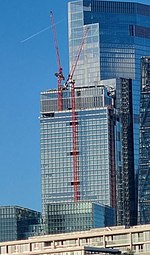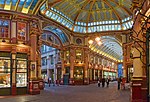London Tavern

The City of London Tavern or London Tavern was a notable meeting place in London during the 18th and 19th centuries. A place of business where people gathered to drink alcoholic beverages and be served food, the tavern was situated in Bishopsgate in the City of London (the site today of Nos. 1–3 Bishopsgate). The original tavern was destroyed in a fire on 7 November 1765 and the new building was designed by William Jupp the elder (with support from William Newton, 1765–1768) and opened in September 1768. In 1828, the proprietor was Charles Bleaden. The building was demolished in 1876. The tavern boasted a large and well-decorated dining room with Corinthian columns. It hosted numerous public and private meetings held to rally support to various political, charitable and other causes.In 1841, Charles Dickens presided at a meeting for the benefit of the Sanatorium for Sick Authors and Artists, and in 1851 at the annual dinner for the General Theatrical Fund. While he was attending a dinner at the London Tavern on 14 April 1851, Dickens learned of the death of his daughter Dora Annie Dickens.
Excerpt from the Wikipedia article London Tavern (License: CC BY-SA 3.0, Authors, Images).London Tavern
Bishopsgate, City of London
Geographical coordinates (GPS) Address Nearby Places Show on map
Geographical coordinates (GPS)
| Latitude | Longitude |
|---|---|
| N 51.5137 ° | E -0.0843 ° |
Address
HSBC UK
Bishopsgate 1
EC2N 3AQ City of London
England, United Kingdom
Open on Google Maps










